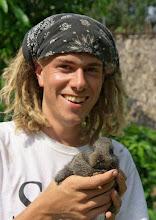 |
Just as it is easy to ignore the munching of a caterpillar once we've idolized its more charismatic self, it can be easy to ignore the value of the droves of insects that we vilify simply because they sting, smell bad, or look like they might get stuck in our hair.
Take this wasp, for instance, that Brian and I spotted yesterday in his semi-arid farm plot:

How would you classify it? If it was in your garden or patio, would swat it?
I remember once, while working in an orchard in California, walking into a portable toilet and closing the door, only to be swarmed by a hive of wasps that had taken up residence there. After soothing my arms in a nearby irrigation ditch, I went to inform my boss about the hazard in the loo. I assumed he would exterminate the wasps: they were clearly a dangerous nuisance, and were of little use to the farm, as far as I could see.
The owners of the farm, however, saw things differently. Every living thing on the farm had a place, and Greg and Coco tried to live in harmony with all life forms as much as possible. They recognized, as we do here at ECHO, that sustainable farming is only possible with the help of a healthy and diverse community of critters.
"These wasps aren't bad," Greg reminded me; "they just need a better place to live." So Greg pulled out a bee smoker and, after calming the wasps as best he could, removed their hives and placed them in a wood pile nearby where the wasps could find and reclaim them.
Often, bugs we identify as evil are actually quite the opposite!
Take another look at the wasp above. What is it wrestling with?
Is that a spider? Yes, and not only that: it's a black widow!

All of a sudden, that wasp takes on a new value, doesn't it? Even if wasps aren't your favorite insects yet, you can probably still agree with Churchill and ancient tacticians who noted that:
Any enemy of my enemy is my friend.
Now, a friendship rooted in mutual distrust of a common foe is better than no friendship at all, but let me show you a little more of this particular wasp's story, so you can learn to value it for its own sake.
Brian and I first spotted this wasp in a cassava bush. It had just finished what likely had been an epic battle, one which ended only when the triumphant wasp stung the spider with a venom that paralyzed, but did not kill, the spider. After dragging the comatose black widow to a nearby patch of sand, the wasp dropped it and spent some time cleaning out burrows it had previously prepared in the ground:
 |
Eventually, the wasp would stow the spider in one of these burrows, lay an egg in it, and seal the hole. The larva would hatch to a ready feast of not-quite-dead spider.
Unfortunately for this particular wasp, the chosen patch of sand was also home to a colony of small ants, who took every opportunity to try to steal the wasp's bounty while she was busy nest-making:

Consequently, the wasp kept having to retrieve the spider and drag it around until she found a spot safe from the foraging ants:

Sometimes, this meant getting off the ground:

In fact, at one point the wasp, seemingly exasperated by the tenacity of her thieving jackals, decided that I would make a good bush in which to hide her hard-earned treasure. She casually crawled up my pant leg, latched onto the strap of the camera I was holding, and hoisted her way on top of the camera, dragging the stunned spider the whole way. There she deposited the spider in the divet created by the viewfinder, and flew off to resume work on her nest. So entranced were Brian and I in the unfolding drama that the presence of two such fierce animals crawling together up my shirt caused neither of us to flinch; instead, we simply marveled at the opportunity we were given to witness this miniature but significant story within the community of life that makes up the ECHO farm.
Incredibly, not 15 minutes later, we came across yet another species of wasp, involved in a similar struggle to provide a food supply for its offspring. While the first wasp preferred spiders as its prey of choice, this wasp harvested grasshoppers.
 |
Here are two different wasp species which, while going about their normal ways of life, have quietly been reducing the pest pressure on our farm.[1] And by encouraging such critters, we have less need to spray pesticides, since a vibrant insect life helps keep everything in balance, the way the creator intended.
---
[1] It is important to note that neither of these prey species are inherently "bad" merely because we label them as pests. Their roles in the ecosystem are as important as those of the wasps. It is only when an ecological imbalance allows their populations to go unchecked that they endanger us or our food supply.


You took these photos? Wow!
ReplyDeleteWhat an awesome story to hear :)
ReplyDelete